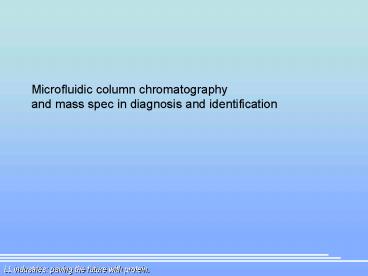Microfluidic column chromatography - PowerPoint PPT Presentation
1 / 22
Title:
Microfluidic column chromatography
Description:
Patient time and resources are not infinite: Example: microarray ... Montr al, Montreal, Canada, and Agilent Technologies, 5301 Stevens Creek ... – PowerPoint PPT presentation
Number of Views:191
Avg rating:3.0/5.0
Title: Microfluidic column chromatography
1
Microfluidic column chromatography and mass spec
in diagnosis and identification
2
The problem Need efficient tool for
diagnosis Cancer Metabolic disease Cardiovascular
disease Samples obtained are small Tissue
biopsy Saliva sample Mouth Swab Blood Patient
time and resources are not infinite Example
microarray
3
The idea Use microfluidic chromatography and
mass spectroscopy to create protein signatures
that can be used in clinical diagnosis and
laboratory research. Traditional
problems Complex mixtures of proteins arent
condusive to mass spec in identification of
individual proteins. Large sample size often not
available. Must reduce complexity of protein
mixture with only small sample size. Need
potentially fast diagnostic tool with reduced
sample handling. Use 2D column chromatography and
mass spec
4
Reducing the complexity of small peptide samples
Microfluidics deals with the behavior, precise
control and manipulation of microliter and
nanoliter volumes of fluids. It is a
multidisciplinary field comprising physics,
chemistry, engineering and biotechnology, with
practical applications to the design of systems
in which such small volumes of fluids will be
used. Microfluidics has emerged only in the 1990s
and is used in the development of DNA chips,
micro-propulsion, micro-thermal technologies, and
lab-on-a-chip technology.
5
(No Transcript)
6
Diverse use for microfluidics in proteomics
(proteofluideome) Enzymatic analysis Protein
arrays Column chromatography Mass spectroscopy
7
Reducing the complexity of small peptide samples
Use 2D (or multi dimensional) column
chromatography- set up sequential purification
and resolution steps of complex protein
mixture. Traditionally
Clean up, quantitation, depletion Ion
exchange, gel filter, reverse phase
lc Trypsin Ion exchange, reverse phase
lc Mass spec
8
Use sequential microfluidic chambers
Integrated Microfluidic Device for Mass
Spectrometry-Based Proteomics and Its Application
to Biomarker Discovery Programs Marie-Helene
Fortier, Eric Bonneil, Paul Goodley, and
Pierre Thibault Department of Chemistry,
Université de Montréal, Montréal, Canada, Caprion
Pharmaceuticals, Montréal, Canada, Institute for
Research in Immunology and Cancer, Université de
Montréal, Montreal, Canada, and Agilent
Technologies, 5301 Stevens Creek Boulevard, Santa
Clara, California 95051
Anal. Chem., 77 (6), 1631 -1640, 2005.
10.1021/ac048506d S0003-2700(04)08506-3
9
nanoCOLLECT The nanoCOLLECT is an automated,
biocompatible system for simultaneous collection
of peptide fractions from microscale or nanoscale
HPLC in microtiter plates, and spotting of
fractions to MALDI MS targets. The easy-to-use
software allows full operation of the system, and
has a teaching tool that provides the flexibility
to program the system to accommodate spotting to
new MALDI MS target geometries.
10
Reducing the complexity of small peptide samples
New proposed workflow
Clean up, quantitation, depletion Ion
exchange, gel filter, reverse phase lc Trypsin
column Spot fractions using nanocollect Mass
spec spots to obtain proteome signature
Sequential microfluidic columns
11
Proteomic signatures of disease Could be
useful in diagnosis of certain cancers, metabolic
disease, responders/nonresponders to a certain
treatment, laboratory research.
12
Early Changes in Protein Expression Detected by
Mass Spectrometry Predict Tumor Response to
Molecular Therapeutics Michelle L. Reyzer1,2,
Robert L. Caldwell1,2, Teresa C. Dugger3, James
T. Forbes3, Christoph A. Ritter6, Marta Guix3,
Carlos L. Arteaga3,4,5 and Richard M.
Caprioli1,2,5 1 Mass Spectrometry Research
Center, Departments of 2 Biochemistry, 3
Medicine, and 4 Cancer Biology, 5
Vanderbilt-Ingram Comprehensive Cancer Center,
Vanderbilt University School of Medicine,
Nashville, Tennessee and 6 Department of
Pharmacology and Institute of Pharmacy, Peter
Holtz Research Center of Pharmacology and
Experimental Therapeutics, Ernst-Moritz-Arndt-Univ
ersitat Greifswald, Greifswald, Germany
Cancer Research 64, 9093-9100, December 15, 2004
13
Niemann Pick Type C Lysosomal storage
disorder caused by dysfunctional NPC1 or
NPC2 Neurodegenerative disorder affecting
1150,000 births Primarily affects children,
usually fatal by early teens. Neonatal jaundice,
learning disorder, vertical gaze palsy,
hepatosplenomegaly, seizures, ataxia, dystonia.
14
Cholesterol trafficking
Failure to traffic cholesterol from the endocytic
system results in NPC disease.
15
NPC disease proposed diagnostic tool
NPC is often diagnosed in early school
years. Diagnosis is made by growing fibroblasts
from skin biopsy and filipin stain. What if we
could diagnose this disease from a mouth swab or
blood sample?
16
NPC1 and NPC2 are necessary for cholesterol
trafficking from endosomes. NPC1-95 of NPC
cases 1287 amino acid membrane protein. Localized
to membranes late endosomes and
lysosomes. Patients often have different
mutations in each copy of the gene. NPC2-5 of
NPC cases 132 amino acids Lysosomal soluble
protein
17
4-4-S cells have an intermediate NPC phenotype
S
18
4-4-S cells have an intermediate NPC phenotype
Cholesterol can move to the plasma membrane, but
cannot move to the ER
19
- Applying laboratory research to
microfluidproteomics - First optimize procedure using wt cells.
Overexpress GFP in one condition, and grow in
heavy media containing radioisotopes. - Mix equal amounts of protein from GFP expressing
and non-expressing cells, subject to microfluid
chromatography and mass spectroscopy. - Determine whether overexpressed GFP can be
resolved on mass spec. (should resolve to a few
lone peaks that arent visible in other cell
line). Compare protein expression signatures by
comparing matrices. - Once procedure optimized, use to compare protein
signatures between wt and mutant cell lines.
Identify possible protein differences using
tandem mass spec.
20
(No Transcript)
21
(No Transcript)
22
(No Transcript)































